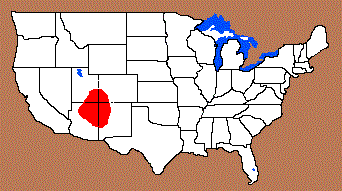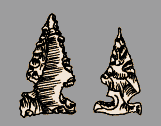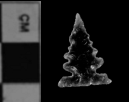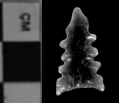Outline is Representative of Size and Shape:
 Serrated
Serrated
 Triangular
Triangular
 Serrated
Serrated Name Details:
Identified By: Eric W. Ritter
Named For: Associated Culture
Date Identified: 1979
Type Site:
Identified By: Eric W. Ritter
Named For: Associated Culture
Date Identified: 1979
Type Site:
Point Validity:
Valid type
Ritter was a distinguished anthropologist at the University of California. He conducted extensive research throughout Baja California. This point was identified in Ritter's Ph.D. dissertation and has several professional references. This is considered a valid type.
Ritter was a distinguished anthropologist at the University of California. He conducted extensive research throughout Baja California. This point was identified in Ritter's Ph.D. dissertation and has several professional references. This is considered a valid type.
Comondu' Triangular Side Notch
Comondu' Serrated Side Notch
Cluster: Comondu' Serrated Side Notch
Description of Physical Characteristics and Flaking Pattern:
This is a small to medium (.5 to 3 inch) side notch point with a flattened cross section. The blade is narrow and may range from straight to excurvate. Uniform square serrations may be present similar to the serration seen on the Stockton series points. The shoulders are square and the base expands at the same angle as the blade. Notches may be present on the lateral edges of the base. The base ranges from straight to concave. This is a thin well made point with a uniform random flaking pattern.
Size Measurements:
Total Length - 18 to 28 mm, Total Width - 11 to 14 mm, Thickness - 2 to 5 mm
Total Length - 18 to 28 mm, Total Width - 11 to 14 mm, Thickness - 2 to 5 mm
Commonly Utilized Material:
Additional Comments:
Loyd Doty notes:
COMONDU’ TRIANGULAR (Side Notch) – was named by archaeologist Eric W. Ritter for examples recovered from Comondu’ Complex type sites in Baja California Sur, Mexico within the Southwestern Cultural region. They are small to medium sized (.50” to 3”) narrow, short or long, thin, well made projectiles that exhibit square serrations very similar to the Stockton and Snaketown types. Examples have straight or concave basal edges. Simple side notched forms without serrations exist, but are not common. Comondu points strongly resemble some Hohokam points found in north central Arizona. However, the Hohokam points are much older and are usually more round in their cross sections. This designation is applied to triangular projectile points, usually small, including both unserrated (“Comondú Triangular”) and serrated (“Comondú Serrated”) types. They appear to be fully equivalent to the points designated as Cottonwood Triangular in the western United States, with the serrated variety corresponding to the Dos Cabezas Serrated type (Wilke and McDonald 1986) and perhaps the Desert Side-notched type in the U.S. These points seem to mark the local appearance of the bow and arrow, and date from roughly A.D. 1000 into the historic period. They are relatively abundant throughout central Baja California. The late prehistoric Comondú culture was defined by Massey (1966b), and the designation of the points associated with it as Comondú points was begun by Ritter (1979). Distribution is Baja California, southern California, and they were in use during the late Prehistoric period.
Loyd Doty notes:
COMONDU’ TRIANGULAR (Side Notch) – was named by archaeologist Eric W. Ritter for examples recovered from Comondu’ Complex type sites in Baja California Sur, Mexico within the Southwestern Cultural region. They are small to medium sized (.50” to 3”) narrow, short or long, thin, well made projectiles that exhibit square serrations very similar to the Stockton and Snaketown types. Examples have straight or concave basal edges. Simple side notched forms without serrations exist, but are not common. Comondu points strongly resemble some Hohokam points found in north central Arizona. However, the Hohokam points are much older and are usually more round in their cross sections. This designation is applied to triangular projectile points, usually small, including both unserrated (“Comondú Triangular”) and serrated (“Comondú Serrated”) types. They appear to be fully equivalent to the points designated as Cottonwood Triangular in the western United States, with the serrated variety corresponding to the Dos Cabezas Serrated type (Wilke and McDonald 1986) and perhaps the Desert Side-notched type in the U.S. These points seem to mark the local appearance of the bow and arrow, and date from roughly A.D. 1000 into the historic period. They are relatively abundant throughout central Baja California. The late prehistoric Comondú culture was defined by Massey (1966b), and the designation of the points associated with it as Comondú points was begun by Ritter (1979). Distribution is Baja California, southern California, and they were in use during the late Prehistoric period.
Distribution: 

Distribution Comments:
This point is primarily found in areas associated with Anasazi sites. This point may be found on the Colorado Plateau in the southern Manti La Sal range and southward to the Su Site of New Mexico and westward to Navajo Mountain.
This point is primarily found in areas associated with Anasazi sites. This point may be found on the Colorado Plateau in the southern Manti La Sal range and southward to the Su Site of New Mexico and westward to Navajo Mountain.
Age / Periods:
Date: 1,000 - 300 B.P.
Cultural Period:Developmental to Historic
Glacial Period: Medieval Warm to Little Ice Age
Culture: Comondu' Culture
Date: 1,000 - 300 B.P.
Cultural Period:Developmental to Historic
Glacial Period: Medieval Warm to Little Ice Age
Culture: Comondu' Culture
Age Details:
Other points in this cluster / Related / Associated Points:





